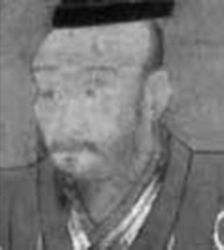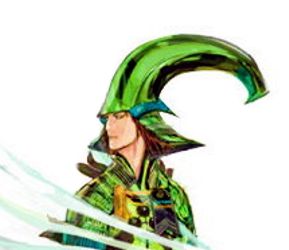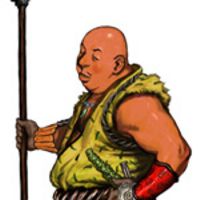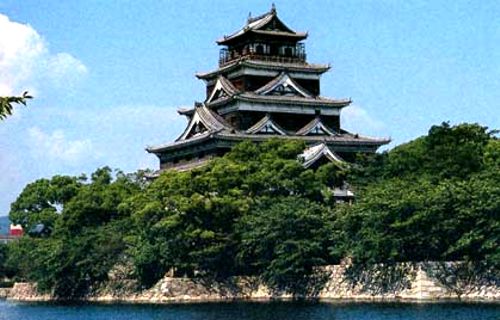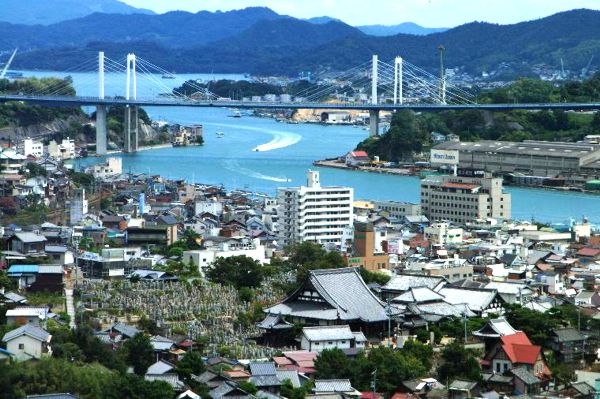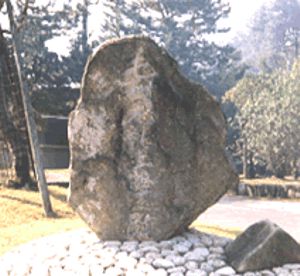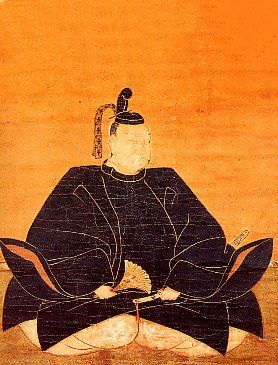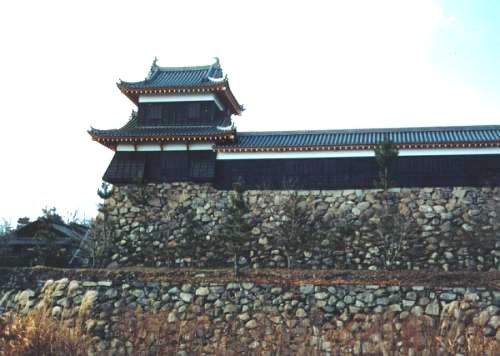| H I S T O R Y .....................OO F........................O D A....................N O B U N A G A ' S ..................E N E M I E S |
 |
MORI CLAN OF AKI |
That 'of Aki' thing signifies only where this clan sprang out of; in its heyday, the clan of Mori practically ruled the entire Western Japan from Suo to Hizen -- on today's map, Mori's domain encompassed the entire land from the edge of the Japanese main island Honshu -- say, Shimonoseki -- to Hiroshima. Quite awesome, aye? And land was not all that the Moris got; of all the warlords in 16th century, the only one which actually could have beaten Oda Nobunaga and Toyotomi Hideyoshi was this one. Not the Takeda clan, even if Shingen were around for long, because the Takedas lacked what the Moris had in abundant: sophistication of arsenal, huge and efficient manpower, and unshaken esprit de corps. The Mori clan was far richer than Oda or Takeda, too, when it came to money and such. While the Oda clan was of course shaky because it virtually consisted of just one man, the Takeda clan was never a solid body; Shingen's famous Generals never even got along well with the son of the patriarch, Takeda Katsuyori. They constantly stood on each other's way, and this internal clash proceeded from worse to worst after Takeda Shingen's death in 1573. So how come Oda was able to beat this formidable foe? Persistence, patience, tricks -- Toyotomi Hideyoshi was a past-master in all those. He won Western Japan from Mori and added it to Oda Nobunaga's domain via all those, even though one day too late -- after Oda himself died in Kyoto in 1582 (for details, see the page about Oda Nobunaga's wars).
The Moris evolved from the Oe clan, vassal of Minamoto Yoritomo of Kamakura (1185-1199). The Oes of Aki were jurists as well as soldiers -- just the kind that the Shogun of the time loved to have around (see History of Japan). The clan's patriarch -- the one who used the name 'Mori' for the first time -- is Mori Hiromoto (1467-1506 -- the full name means 'vast town by the forest'). Mori Hiromoto inherited his predecessors' pattern of conflicts and ambition. In the churning period under the misrule of the Ashikaga shogunate in 1400's, Oe Toyomoto ('administer of the town', 1444-1476), the head of the clan, went to the senseless Onin war under the overlordship of the Ouchi clan. He did this because his own clan wasn't so strong yet -- but he had grander plans, which, alas, got unrealized in his lifetime. Mori Himoroto wanted the same thing, i.e. supremacy in Western Japan and even in the Kyushu isles, but he, too, faced the same lack of assets. Nonetheless the Moris always possessed immeasurable guts, which manifested in the best and the most famous of them all, Mori Motonari ('vocation of the town', 1497-1571). At first he wasn't the clan's chief. It was his older brother, the short-lived Mori Okimoto (1493-1516) who received the legacy of chiefdom. After Okimoto died, Mori Motonari was supposed to rear Okimoto's son, Mori Komatsu, until he was ready to step into Okimoto's shoes. But the kid died in 1523. And Mori Mototsuna ('link of the town'), Motonari's younger brother who also wanted the seat, was beaten up by Motonari in an interclan war and died, too -- so finally the real power merged with the official title.
Mori Motonari in a videogame -- in the wrong armor (2005)
Motonari lifted his clan up from vassaldom by the usual ways of the warring Japan: when he got the order from the Ouchis to defend the domain from an invasion by the famous Amako clan in 1521, Mori Motonari marched his men to Amako's camp -- to join them. The Ouchis got defeated, and a year later Mori Motonari acquired an easy alliance with his neighbor, the Kikkawa clan, by marrying one of their girls. Afterwards, he reassessed the power of the Amakos and found them much beneath his standard. That meant only one thing -- if your overlord was so weak, don't bother to stick around, you'd better taken what he got instead. At least that's Mori Motonari's reasoning. So, Mori left them, and, since his clan was still not as strong as he wanted it to be yet, he reunited himself with the Ouchis. In all of Motonari's decisions, there was a Buddhist warrior-monk involved: the famous Ekei of Ankoku temple, who would die after losing the last battle against Tokugawa clan at Seki plains in 1600.
Ekei, the Mori clan's counsellor
Ekei was the favorite of the clan all of his life. Claiming 'independence' (though everybody in Japan knew he's the Moris' counsellor), Ekei was able to do much CIA-like work in other provinces, especially around Oda Nobunaga's and Tokugawa Ieyasu's cities like Gifu, Azuchi, Okazaki and Hamamatsu. Ekei's own clan by DNA was actually Takeda. In 1550, Mori Motonari's famous sons got adopted by two neighboring warlord clans and became their chiefs. These sons wouldn't use their dad's last name since then; you have known them as Kikkawa Motoharu (1530-1586) and Kobayakawa Takakage (1533-1580), fine warriors and were every inch Motonarists -- they shared the same vision. Mori Motonari added more and more tributary vassals and defeated foes into his archives of conquests, altering the history of the Western Japanese clans such as Sue, Inoue, and Murakami. Then he moved his clan's HQ to Hiroshima.
Mori
Motonari's Hiroshima castle is not an imposing sight
-- it never fails to disappoint tourists
Hiroshima in 2005 -- it was on the former domain of the Mori clan that Harry Truman dropped atomic bombs in 1945
In 1555, Mori Motonari told everybody that he would, from then on, retire. The chief of the clan was since then his son, Mori Takamoto ('eagle of the town', 1523-1563). But, as you have seen in virtually every warlord's bio, retirement never meant peaceful pursuits such as golfing and fishing -- so, seen from every angle, the power still was Motonari's. It was him, too, who decided that the clan was great enough now to attempt to wrestle the Kyushu isles off the clutch of the Roman Catholic warlord of the Otomo clan. This was in 1558. The Moris lost the series of battles, though, and Mori Motonari thought he'd better mind his already-stretched territory in the main island without aspiring to conquer more -- this was to be the Moris' policy throughout the remaining years of the Warring States period.
Monument
of Mori Motonari at the 'Shrine Island', Miyashima.
Mori Takamoto died in 1563, and Motonari, as if in retaliation (though the death was not in the battlefield), crushed the Amako clan thoroughly. Motonari gave the title of the head of the clan to Takamoto's son, Mori Terumoto (1553-1625, 'the shining town'). Then this inimitable manowar died in 1571. Just right on time for Oda Nobunaga, who was preparing his all-out campaign to have Japan under his own overlordship, from Gifu.
Mori
Terumoto's official pic when he was around 50 years old.
The prospect was shining, alright, but not the man. There was nothing that was very wrong in Mori Terumoto's assets; he got everything he needed. A vast, 'modern', effective Army and Navy was solidly behind his back; his awesome uncles formed a deadly duet that scared anyone; there was no warlord under his overlordship that dreamed of challenging the Mori clan. But Mori Terumoto felt intimidated by Oda Nobunaga's ambition to arrive at 'Japan United', partly because he didn't harbor such an ambition himself. Well, his grandpa didn't, either, after learning from experience; his uncles shared the 'MYOB' principle; but they weren't afraid of Oda nonetheless. Terumoto was too scared, to such an extent that he never, ever, decided to go to war against Oda Nobunaga directly. What he did was getting himself busy in an endless series of sending troops to assist whosoever was at war against Oda -- including the warrior-monks.
Koriyama castle, the final HQ of the Mori clan
The details of Mori Terumoto's wars are at other pages (see Oda Nobunaga's Other Wars). In short, he lost his overlordship in 1582, and became a mere vassal of the next ruler of Japan, the former General of the Oda Army, Toyotomi Hideyoshi, who died in 1599. Mori Terumoto was alright under Toyotomi's rule, as the latter was actually kind of insecure about his pedigree and tended to value 'real samurai' clans like the Moris. Ekei even enjoyed the Toyotomi Golden Years as the best in his life -- they had been friendly toward each other since Oda Nobunaga's days in Gifu (early 1570's). Some local history even said that it was Ekei who persuaded the rural warlord Hachisuka Koroku to join Oda Nobunaga in 1569, and that Ekei did it simply because he liked Toyotomi Hideyoshi. The Hachisuka clan would be vital in Oda's campaign to get the Saitos' Mino. In 1600, Mori Terumoto caused great loss for the pro-Toyotomi party in the scary battle of Seki plains via a shameful surrender to Tokugawa Ieyasu, and lost whatever else was left but status as a defeated foe in the eyes of the clan that reigned since then, the Tokugawa. It was Ekei who advised Mori Terumoto to join the party. So he died for it, because Tokugawa couldn't stand his snooping around for years. That was not the last of the Mori clan. In 1850's, they would once more got onto the national politics in the Japanese civil war -- of the Tokugawa clan versus Emperor Meiji -- for whom the Moris fought this time. After waiting for hundreds of years, the Mori clan finally got the chance to whack the Tokugawas off, for good. Click here for this episode of history. |
| Takeda Shingen | Uesugi Kenshin | Asai Nagamasa | Imagawa Yoshimoto | Warrior-Monks | ||||
| BIOGRAPHIES & PICTURES OF | Mori Terumoto | ODA NOBUNAGA'S ENEMIES | ||||||
Site, designs & rap © 1996, 1997, 1998, 1999, 2000, 2001, 2002, 2003, 2004, 2005, 2006 Nina Wilhelmina
HOME
![]() LINKS
LINKS
![]() CONTACT
CONTACT
![]() CREDITS
CREDITS
![]() COMMENTS
COMMENTS
All rights
reserved. Every borrowed image at this site is put for non-profit educational
purposes only.
Credits for pictures of Oda Nobunaga that were sent by a number of visitors
of this site are attached to every item at the picture pages.

